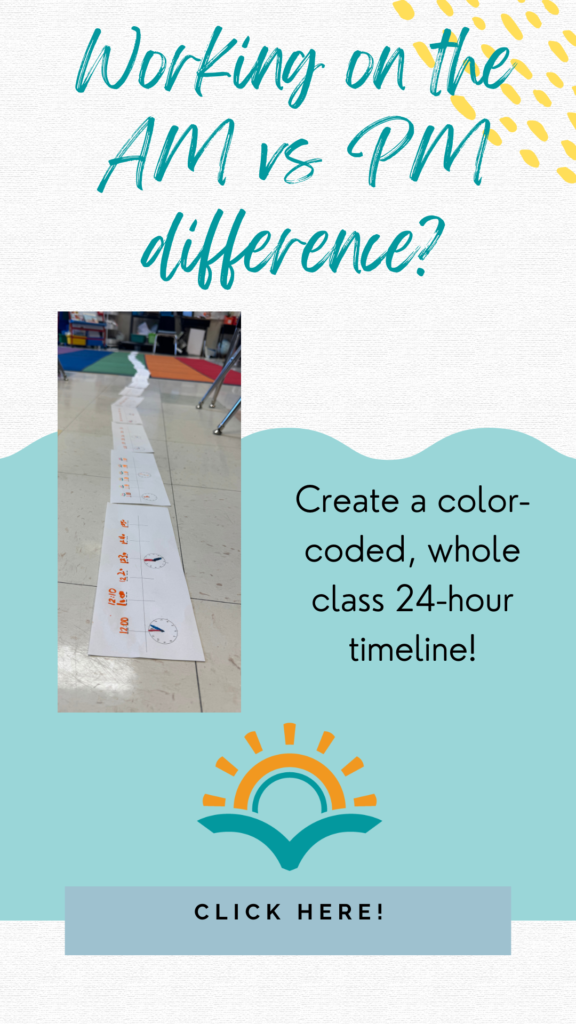Are you looking for engaging ways to teach telling time for first graders? Let’s dive in to some creative ways to teach this tricky topic to first graders!
Telling time for first graders: a starting point
This mean seem obvious to some, but you need to gauge your first grade students’ awareness of time before digging into the details of analog clocks. Can they estimate 1 minute? Do they know about how long an hour is? Do they effectively use time words like before, after, and during?
Before you begin your first grade telling time unit, tune in to how your students are using their growing knowledge of the concept of time.

Telling time to the hour Activities: School Schedule
One of my favorite ways to introduce telling time to the hour is to make an interactive schedule of our school day. First graders are usually aware of the time that school starts and, more or less, the time that school ends.
To kickstart our time unit, my first graders and I set an alarm to go off every hour on the hour. When it dings, we pause whatever we are doing to a) look at the analog clock in the front of the room, b) draw the time on a paper and c) write what we are doing at that time. We then use a clothesline to make a growing timeline of school day. This is a great way to increase students’ awareness of the passage of time using something very familiar: their school schedule!
This activity is also helpful for practicing time language, especially for multilingual students. “Do we go to gym before or after we eat lunch?” “What happens right before we leave at the end of the day?”
Pro tip: leave enough space on your clothesline timeline to later be able to add in the half hours!

Build more time sense with a time line of students’ birthdays!
In this incredibly simple activity, students work together to create a timeline of their birthdays over the school year. See below for the timeline we created in my classroom last year!

Interactive Telling Time games
Another way to teach telling time to first graders is through an interactive telling time game! There are so many options out there, but here are a few that I love!
Around the Room Telling Time Game
Students learn best when they’re moving! This game is almost so simple it hurts! In Version 1, you post digital or word times (3:00 or three o’ clock) around the classroom on printed paper. Students walk around the room with practice clocks and work with partners to make the analog clock show the given time. Partner A makes the time, Partner B checks their work. They keep going around the room, switching tasks each time!
Version 2 is simply the reverse: You post practice analog clocks – or printed ones! – around the classrooms. Students walk around with a recording sheet of paper, noting the time shown on each clock. This version is helpful if a) you don’t have enough practice clocks for all students or b) you want the students to have something to turn in at the end of the game!

Telling Time Board Game
Another learn to tell time time game is a “What time is it?” board game. These are so easy and fun to make on your own! Students roll a dice to move around the game board. Each space requires that the student make the time on their practice clock OR identify the time shown by the analog clock on the board! Throw in a couple of “move back 3” or “skip ahead 2” to keep things fun and interesting for your learners! Your students will love playing games telling time!

More Ideas: Telling time for first graders Worksheets
Do your students need more practice? Telling time worksheets completed independently, with a partner, or in small groups can be a great way to solidify students’ knowledge! Here are some of my favorite telling time worksheet formats:
- Match the clock to the time: Perfect for students just starting out, these worksheets require learners to draw a line connecting an analog clock to its digital time.
- Fill in the clock hands: With these, students are provided a digital time and are asked to draw in the hour and minute hands of an analog clock to correspond with it.
- Schedule riddles: For students who are ready for more of a challenge, riddles are perfect! Students read about various fictional students’ routines and are prompted to create or fill in their schedule.
I hope this post has given you some ideas for teaching telling time for first graders!



